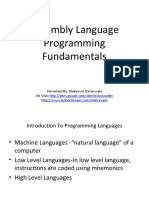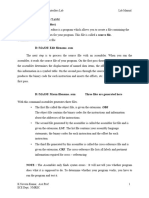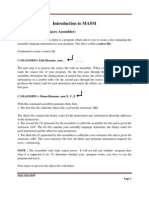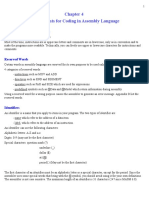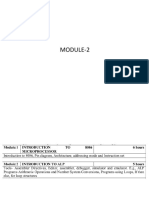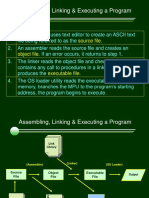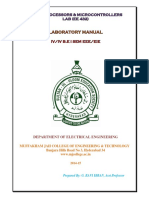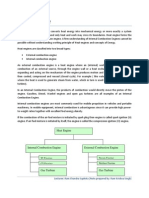0 ratings0% found this document useful (0 votes)
93 viewsModular Programming
This document discusses key concepts in modular programming including assemblers, linkers, public and external directives, libraries, and macros. Assemblers convert source code modules into object files while linkers combine object files into a single executable. Public and external directives allow communication between modules by declaring labels as available or external. Libraries are collections of common procedures that can be reused across programs. Macros provide a way to group instructions that perform a specific task to execute more efficiently than procedures.
Uploaded by
Lohith B M BandiCopyright
© © All Rights Reserved
Available Formats
Download as PPTX, PDF, TXT or read online on Scribd
0 ratings0% found this document useful (0 votes)
93 viewsModular Programming
This document discusses key concepts in modular programming including assemblers, linkers, public and external directives, libraries, and macros. Assemblers convert source code modules into object files while linkers combine object files into a single executable. Public and external directives allow communication between modules by declaring labels as available or external. Libraries are collections of common procedures that can be reused across programs. Macros provide a way to group instructions that perform a specific task to execute more efficiently than procedures.
Uploaded by
Lohith B M BandiCopyright
© © All Rights Reserved
Available Formats
Download as PPTX, PDF, TXT or read online on Scribd
You are on page 1/ 14
MODULAR PROGRAMMING
MODULAR PROGRAMMING
• Many programs are too large to be developed
by one person.
• This means that programs are routinely
developed by teams of programmers.
Assembler and Linker
• Assembler program converts a symbolic source
module (file) into a hexadecimal object file.
• The linker program, reads the object files that are
created by the assembler program and links them
together into a single execution file.
PUBLIC and EXTRN
• The PUBLIC and EXTRN directives are very
important to modular programming because they
allow communications between modules.
• EXTRN , PUBLIC informs the assembler that the
names of procedures and labels declared after
this directive have been already defined in some
other assembly language modules.
• PUBLIC is used to declare labels of code, data, or
entire segments that are available to other
program modules.
• When a data or Procedure needs to be accessed by
other modules, it is declared as Public.
• Public data1 OR Public mul
• EXTRN (external) declares that labels are external
to a module.
• When a module needs to use data or code that is
defined elsewhere, it should use directice EXTRN
meaning that the labels being used with EXTRN
are external to the module.
• Without these statements, modules could not be
linked together to create a program by using
modular programming techniques.
.model small
.data
extrn data1:byte,data2:byte, here:near
.code mov bh,data2
mov ax,@data call here
mov ax, 0FFFFh
mov ds,ax mov ah,4ch
mov bl,data1 int 21h
end
.model small
.data mov ax,5678h
data1 db 12h mov si,4567h
data2 db 24h ret
.code here endp
mov ax,@data
mov ds,ax mov ah,4ch
public data1,data2,here int 21h
here proc near end
Libraries
• Library files are collections of procedures that are
used by many different programs.
• These procedures are assembled and compiled
into a library file by the LIB program that
accompanies the MASM assembler program.
• Libraries allow common procedures to be collected
into one place so they can be used by many
different applications.
Macros
• A macro is a group of instructions that perform
one task, just as a procedure performs one task.
• In macros, all the instructions defined in the
macro, is inserted in the program at the point of
usage.
• Creating a macro is very similar to creating a new
opcode.
• Macro sequences execute faster than
procedures because there is no CALL or RET
instruction to execute.
• The MACRO and ENDM directives delineate a
macro sequence.
• The first statement of a macro is the MACRO
instruction, which contains the name of the
macro and any parameters associated with it.
Macro_name MACRO arg1, arg2,…..argn
Statement 1
Statement 2
Statement k
EndM
• The last statement of a macro is the ENDM
instruction, which is placed on a line by itself.
• Never place a label in front of the ENDM
statement. If a label appears before ENDM, the
macro will not assemble.
• Sometimes, macros contain local variables.
• A local identifier is one that appears in the macro,
but is not available outside the macro.
• To define a local variable, we use the LOCAL
directive.
You might also like
- LEcture 14 Assembly Process and Modular ProgrammingNo ratings yetLEcture 14 Assembly Process and Modular Programming23 pages
- Assemblylanguageprogrammingfundamentals 140313050423 Phpapp02No ratings yetAssemblylanguageprogrammingfundamentals 140313050423 Phpapp0249 pages
- Assembly Language Programming: Bilal Zahoor Kashmir University North CampusNo ratings yetAssembly Language Programming: Bilal Zahoor Kashmir University North Campus31 pages
- Chapter 4 Assembly Language and Programming100% (2)Chapter 4 Assembly Language and Programming85 pages
- Assignment No.: 01: Name: Shraddha Umesh Mulay Roll No.: 221083 GR No.: 22020260 Sy-ANo ratings yetAssignment No.: 01: Name: Shraddha Umesh Mulay Roll No.: 221083 GR No.: 22020260 Sy-A8 pages
- Assembler Directive in Microprocesser 8086No ratings yetAssembler Directive in Microprocesser 808618 pages
- Requirements For Coding in Assembly LanguageNo ratings yetRequirements For Coding in Assembly Language7 pages
- It153l Introduction To Assembly Language RevisedNo ratings yetIt153l Introduction To Assembly Language Revised95 pages
- Computer Systems Organization With Assembly LanguageNo ratings yetComputer Systems Organization With Assembly Language31 pages
- Chapter 4 - Requirements For Coding in Assembly LanguageNo ratings yetChapter 4 - Requirements For Coding in Assembly Language19 pages
- Introduction To ALP (Assember Directives)No ratings yetIntroduction To ALP (Assember Directives)16 pages
- 2 The Art of Assembly Language ProgrammingNo ratings yet2 The Art of Assembly Language Programming6 pages
- 6-Procedure and Macro in Assembly Language Program94% (35)6-Procedure and Macro in Assembly Language Program13 pages
- Computer Organization and Assembly Language: Muhammad Usman100% (1)Computer Organization and Assembly Language: Muhammad Usman33 pages
- Introduction To Macros: Macro - Name A1, A2, - . - , AnNo ratings yetIntroduction To Macros: Macro - Name A1, A2, - . - , An7 pages
- Introduction To Assembly Language Chapter 1No ratings yetIntroduction To Assembly Language Chapter 127 pages
- Introduction To Assembly Language (Chapter 1)100% (2)Introduction To Assembly Language (Chapter 1)27 pages
- Object-Oriented Programming Made Simple: A Practical Guide with Java ExamplesFrom EverandObject-Oriented Programming Made Simple: A Practical Guide with Java ExamplesNo ratings yet
- Computer Science: Learn about Algorithms, Cybersecurity, Databases, Operating Systems, and Web DesignFrom EverandComputer Science: Learn about Algorithms, Cybersecurity, Databases, Operating Systems, and Web DesignNo ratings yet
- Docker: The Complete Guide to the Most Widely Used Virtualization Technology. Create Containers and Deploy them to Production Safely and Securely.: Docker & Kubernetes, #1From EverandDocker: The Complete Guide to the Most Widely Used Virtualization Technology. Create Containers and Deploy them to Production Safely and Securely.: Docker & Kubernetes, #1No ratings yet
- Author's Accepted Manuscript: Signal Processing: Image CommunicationNo ratings yetAuthor's Accepted Manuscript: Signal Processing: Image Communication51 pages
- Accepted Manuscript: 10.1016/j.patcog.2018.01.035No ratings yetAccepted Manuscript: 10.1016/j.patcog.2018.01.03546 pages
- Deep Learning With Pytorch: Ai Courses by OpencvNo ratings yetDeep Learning With Pytorch: Ai Courses by Opencv5 pages
- Research Article: Indian Classical Dance Action Identification and Classification With Convolutional Neural NetworksNo ratings yetResearch Article: Indian Classical Dance Action Identification and Classification With Convolutional Neural Networks11 pages
- Nrityantar: Pose Oblivious Indian Classical Dance Sequence Classification SystemNo ratings yetNrityantar: Pose Oblivious Indian Classical Dance Sequence Classification System6 pages
- Pump Gas Race Gas: Effective Compression RatioNo ratings yetPump Gas Race Gas: Effective Compression Ratio1 page
- Model: Frequency: Fuel Type: C2250 D5 50 Diesel: Generator Set Data SheetNo ratings yetModel: Frequency: Fuel Type: C2250 D5 50 Diesel: Generator Set Data Sheet3 pages
- Shangha I Diesel Engine G128ZL Caf Dong Feng China G 10600240 5No ratings yetShangha I Diesel Engine G128ZL Caf Dong Feng China G 10600240 52 pages
- On-Premises Versus Secaas Security Models: AbstractNo ratings yetOn-Premises Versus Secaas Security Models: Abstract6 pages
- WWW - Manaresults.co - In: MAY/JUNE-2023 Dcme - Fifth Semester Examination Board Diploma Examination, (C-20)No ratings yetWWW - Manaresults.co - In: MAY/JUNE-2023 Dcme - Fifth Semester Examination Board Diploma Examination, (C-20)3 pages
- Doc-20231219-Wa0034. 20231219 164426 0000No ratings yetDoc-20231219-Wa0034. 20231219 164426 000031 pages
- (QSP-NPD-01) Process For Advanced Product Quality Planning (APQP)100% (1)(QSP-NPD-01) Process For Advanced Product Quality Planning (APQP)9 pages
- Technical Information: Introduction To STARDOMNo ratings yetTechnical Information: Introduction To STARDOM8 pages
- En 62061 and Recommendations For The Practical Use - Derek Jones100% (1)En 62061 and Recommendations For The Practical Use - Derek Jones17 pages
- LEcture 14 Assembly Process and Modular ProgrammingLEcture 14 Assembly Process and Modular Programming
- Assemblylanguageprogrammingfundamentals 140313050423 Phpapp02Assemblylanguageprogrammingfundamentals 140313050423 Phpapp02
- Assembly Language Programming: Bilal Zahoor Kashmir University North CampusAssembly Language Programming: Bilal Zahoor Kashmir University North Campus
- Assignment No.: 01: Name: Shraddha Umesh Mulay Roll No.: 221083 GR No.: 22020260 Sy-AAssignment No.: 01: Name: Shraddha Umesh Mulay Roll No.: 221083 GR No.: 22020260 Sy-A
- Computer Systems Organization With Assembly LanguageComputer Systems Organization With Assembly Language
- Chapter 4 - Requirements For Coding in Assembly LanguageChapter 4 - Requirements For Coding in Assembly Language
- 6-Procedure and Macro in Assembly Language Program6-Procedure and Macro in Assembly Language Program
- Computer Organization and Assembly Language: Muhammad UsmanComputer Organization and Assembly Language: Muhammad Usman
- Introduction To Macros: Macro - Name A1, A2, - . - , AnIntroduction To Macros: Macro - Name A1, A2, - . - , An
- Object-Oriented Programming Made Simple: A Practical Guide with Java ExamplesFrom EverandObject-Oriented Programming Made Simple: A Practical Guide with Java Examples
- Computer Science: Learn about Algorithms, Cybersecurity, Databases, Operating Systems, and Web DesignFrom EverandComputer Science: Learn about Algorithms, Cybersecurity, Databases, Operating Systems, and Web Design
- Docker: The Complete Guide to the Most Widely Used Virtualization Technology. Create Containers and Deploy them to Production Safely and Securely.: Docker & Kubernetes, #1From EverandDocker: The Complete Guide to the Most Widely Used Virtualization Technology. Create Containers and Deploy them to Production Safely and Securely.: Docker & Kubernetes, #1
- Author's Accepted Manuscript: Signal Processing: Image CommunicationAuthor's Accepted Manuscript: Signal Processing: Image Communication
- Research Article: Indian Classical Dance Action Identification and Classification With Convolutional Neural NetworksResearch Article: Indian Classical Dance Action Identification and Classification With Convolutional Neural Networks
- Nrityantar: Pose Oblivious Indian Classical Dance Sequence Classification SystemNrityantar: Pose Oblivious Indian Classical Dance Sequence Classification System
- Model: Frequency: Fuel Type: C2250 D5 50 Diesel: Generator Set Data SheetModel: Frequency: Fuel Type: C2250 D5 50 Diesel: Generator Set Data Sheet
- Shangha I Diesel Engine G128ZL Caf Dong Feng China G 10600240 5Shangha I Diesel Engine G128ZL Caf Dong Feng China G 10600240 5
- On-Premises Versus Secaas Security Models: AbstractOn-Premises Versus Secaas Security Models: Abstract
- WWW - Manaresults.co - In: MAY/JUNE-2023 Dcme - Fifth Semester Examination Board Diploma Examination, (C-20)WWW - Manaresults.co - In: MAY/JUNE-2023 Dcme - Fifth Semester Examination Board Diploma Examination, (C-20)
- (QSP-NPD-01) Process For Advanced Product Quality Planning (APQP)(QSP-NPD-01) Process For Advanced Product Quality Planning (APQP)
- En 62061 and Recommendations For The Practical Use - Derek JonesEn 62061 and Recommendations For The Practical Use - Derek Jones


